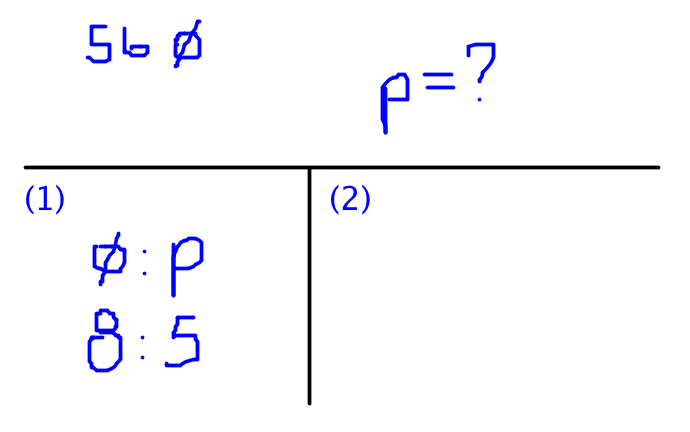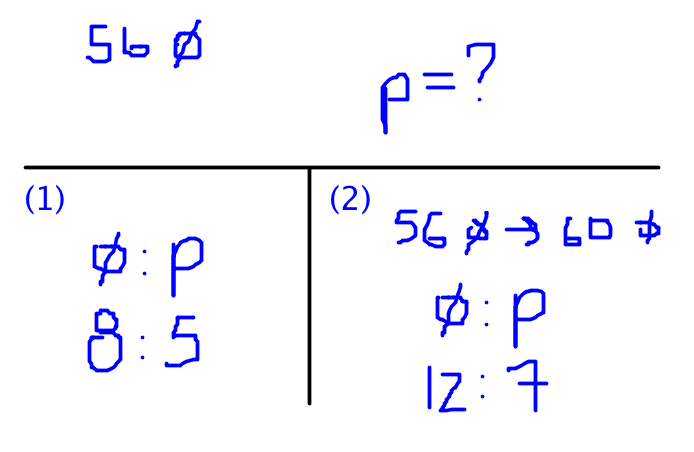-
Target Test Prep's 2024 GMAT Focus Edition prep is discounted for the BTG community!
Redeem
GMAT Data Sufficiency: Ratio Stories
 Recently, we took a look at a story problem dealing with ratios, and I finished up by giving you a second problem to test your skills. How did you do?
Recently, we took a look at a story problem dealing with ratios, and I finished up by giving you a second problem to test your skills. How did you do?
If you havent already, try the GMATPrep problem below and then well talk about it. Give yourself about 2 minutes. Go!
* A certain wooded lot contains 56 oak trees. How many pine trees does the lot contain?(1) The ratio of the number of oak trees to the number of pine trees in the lot is 8 to 5.
(2) If the number of oak trees were increased by 4 and the number of pine trees remained unchanged, the ratio of the number of oak trees to the number of pine trees in the lot would be 12 to 7.
Ready? (If youre wondering where / what the answer choices are, click here to learn about Data Sufficiency before proceeding with this problem.)
The question stem doesnt give a lot of info. There are 56 oak trees and we need to find the number of pine trees.
Statement (1) is shorter, so lets start there.
(1) The ratio of the number of oak trees to the number of pine trees in the lot is 8 to 5.
Okay, a ratio. Is that useful?
Aside: Wondering why I wrote my os like that? If I didn't add the slash, I might mix them up with zeros. I also put slashes through zs (they look like my 2s) and ss (they look like my 5s).
Okay, so if you have a ratio and you also have the real number for any one portion of that ratio, then you can figure out everything in that ratio.
In this case, if there are 56 oak trees in a ratio of 8 oaks to 5 pines, then the unknown multiplier is 56/8 = 7. There are (8)(7) = 56 oaks and (5)(7) = 35 pines.
This is data sufficiency, so you dont actually need to calculate that; you just need to be able to tell that you can calculate it. Statement (1) is sufficient. Cross off choices (B), (C), and (E).
Next up, the slightly more annoying (by length) statement (2):
(2) If the number of oak trees were increased by 4 and the number of pine trees remained unchanged, the ratio of the number of oak trees to the number of pine trees in the lot would be 12 to 7.
Hmm. More complicated. Lets see: there are 56 oak trees, so if they are increased by 4, then there would be 60 oak trees. We can still use p to represent the pines; that number doesnt change.
Oh, check that out. Im glad I wrote that out so that I could see what was going on. Turns out, we have the same info that statement (1) gave us: a real number for the oak trees and a ratio. That allows you to calculate the new number of pines, which is the same as the old number.
Okay, statement (2) also works, so the correct answer is (D).
By the way, just to practice your computation skills, how many pines are there in the second scenario? (You dont actually have to solve this on data sufficiency, of course.)
If there are 60 oaks, then the unknown multiplier is 60/12 = 5. Therefore, there are (7)(5) = 35 pine trees.
Key Takeaways: Write everything out!
(1) It can be tempting to eyeball some information and go with a gut feel, but this can sometimes get you into trouble. Ive seen people look at statement (2) and think that its not sufficient without actually writing out the work. Theyll sometimes think that you can calculate the new number but not the old one, forgetting that the number of pine trees doesn't change.
(2) Know the unknown multiplier rule: if you have the ratio and one real number for anything in that ratio, then you can calculate the real numbers for all parts of that ratio.
* GMATPrep questions courtesy of the Graduate Management Admissions Council. Usage of this question does not imply endorsement by GMAC.
Recent Articles
Archive
- May 2024
- April 2024
- March 2024
- February 2024
- January 2024
- December 2023
- November 2023
- October 2023
- September 2023
- July 2023
- June 2023
- May 2023
- April 2023
- March 2023
- February 2023
- January 2023
- December 2022
- November 2022
- October 2022
- September 2022
- August 2022
- July 2022
- June 2022
- May 2022
- April 2022
- March 2022
- February 2022
- January 2022
- December 2021
- November 2021
- October 2021
- September 2021
- August 2021
- July 2021
- June 2021
- May 2021
- April 2021
- March 2021
- February 2021
- January 2021
- December 2020
- November 2020
- October 2020
- September 2020
- August 2020
- July 2020
- June 2020
- May 2020
- April 2020
- March 2020
- February 2020
- January 2020
- December 2019
- November 2019
- October 2019
- September 2019
- August 2019
- July 2019
- June 2019
- May 2019
- April 2019
- March 2019
- February 2019
- January 2019
- December 2018
- November 2018
- October 2018
- September 2018
- August 2018
- July 2018
- June 2018
- May 2018
- April 2018
- March 2018
- February 2018
- January 2018
- December 2017
- November 2017
- October 2017
- September 2017
- August 2017
- July 2017
- June 2017
- May 2017
- April 2017
- March 2017
- February 2017
- January 2017
- December 2016
- November 2016
- October 2016
- September 2016
- August 2016
- July 2016
- June 2016
- May 2016
- April 2016
- March 2016
- February 2016
- January 2016
- December 2015
- November 2015
- October 2015
- September 2015
- August 2015
- July 2015
- June 2015
- May 2015
- April 2015
- March 2015
- February 2015
- January 2015
- December 2014
- November 2014
- October 2014
- September 2014
- August 2014
- July 2014
- June 2014
- May 2014
- April 2014
- March 2014
- February 2014
- January 2014
- December 2013
- November 2013
- October 2013
- September 2013
- August 2013
- July 2013
- June 2013
- May 2013
- April 2013
- March 2013
- February 2013
- January 2013
- December 2012
- November 2012
- October 2012
- September 2012
- August 2012
- July 2012
- June 2012
- May 2012
- April 2012
- March 2012
- February 2012
- January 2012
- December 2011
- November 2011
- October 2011
- September 2011
- August 2011
- July 2011
- June 2011
- May 2011
- April 2011
- March 2011
- February 2011
- January 2011
- December 2010
- November 2010
- October 2010
- September 2010
- August 2010
- July 2010
- June 2010
- May 2010
- April 2010
- March 2010
- February 2010
- January 2010
- December 2009
- November 2009
- October 2009
- September 2009
- August 2009

